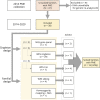Progressive Myoclonus Epilepsies: Diagnostic Yield With Next-Generation Sequencing in Previously Unsolved Cases
- PMID: 34786481
- PMCID: PMC8589262
- DOI: 10.1212/NXG.0000000000000641
Progressive Myoclonus Epilepsies: Diagnostic Yield With Next-Generation Sequencing in Previously Unsolved Cases
Abstract
Background and objectives: To assess the current diagnostic yield of genetic testing for the progressive myoclonus epilepsies (PMEs) of an Italian series described in 2014 where Unverricht-Lundborg and Lafora diseases accounted for ∼50% of the cohort.
Methods: Of 47/165 unrelated patients with PME of indeterminate genetic origin, 38 underwent new molecular evaluations. Various next-generation sequencing (NGS) techniques were applied including gene panel analysis (n = 7) and/or whole-exome sequencing (WES) (WES singleton n = 29, WES trio n = 7, and WES sibling n = 4). In 1 family, homozygosity mapping was followed by targeted NGS. Clinically, the patients were grouped in 4 phenotypic categories: "Unverricht-Lundborg disease-like PME," "late-onset PME," "PME plus developmental delay," and "PME plus dementia."
Results: Sixteen of 38 (42%) unrelated patients reached a positive diagnosis, increasing the overall proportion of solved families in the total series from 72% to 82%. Likely pathogenic variants were identified in NEU1 (2 families), CERS1 (1 family), and in 13 nonfamilial patients in KCNC1 (3), DHDDS (3), SACS, CACNA2D2, STUB1, AFG3L2, CLN6, NAXE, and CHD2. Across the different phenotypic categories, the diagnostic rate was similar, and the same gene could be found in different phenotypic categories.
Discussion: The application of NGS technology to unsolved patients with PME has revealed a collection of very rare genetic causes. Pathogenic variants were detected in both established PME genes and in genes not previously associated with PME, but with progressive ataxia or with developmental encephalopathies. With a diagnostic yield >80%, PME is one of the best genetically defined epilepsy syndromes.
Copyright © 2021 The Author(s). Published by Wolters Kluwer Health, Inc. on behalf of the American Academy of Neurology.
Figures


Similar articles
-
Progressive myoclonus epilepsies-Residual unsolved cases have marked genetic heterogeneity including dolichol-dependent protein glycosylation pathway genes.Am J Hum Genet. 2021 Apr 1;108(4):722-738. doi: 10.1016/j.ajhg.2021.03.013. Am J Hum Genet. 2021. PMID: 33798445 Free PMC article.
-
Debate: Does genetic information in humans help us treat patients? PRO--genetic information in humans helps us treat patients. CON--genetic information does not help at all.Epilepsia. 2008 Dec;49 Suppl 9:13-24. doi: 10.1111/j.1528-1167.2008.01922.x. Epilepsia. 2008. PMID: 19087113 Review.
-
A recurrent de novo mutation in KCNC1 causes progressive myoclonus epilepsy.Nat Genet. 2015 Jan;47(1):39-46. doi: 10.1038/ng.3144. Epub 2014 Nov 17. Nat Genet. 2015. PMID: 25401298 Free PMC article.
-
Whole exome sequencing identifies variable expressivity of CLN6 variants in Progressive myoclonic epilepsy affected families.Epilepsy Res. 2024 Mar;201:107283. doi: 10.1016/j.eplepsyres.2023.107283. Epub 2023 Dec 17. Epilepsy Res. 2024. PMID: 38382230
-
The molecular genetic bases of the progressive myoclonus epilepsies.Adv Neurol. 1999;79:383-98. Adv Neurol. 1999. PMID: 10514828 Review.
Cited by
-
2022 Overview of Metabolic Epilepsies.Genes (Basel). 2022 Mar 12;13(3):508. doi: 10.3390/genes13030508. Genes (Basel). 2022. PMID: 35328062 Free PMC article. Review.
-
Non-convulsive Status Epilepticus in SEMA6B-Related Progressive Myoclonic Epilepsy: A Case Report With Literature Review.Front Pediatr. 2022 Apr 28;10:859183. doi: 10.3389/fped.2022.859183. eCollection 2022. Front Pediatr. 2022. PMID: 35573939 Free PMC article.
-
Progressive myoclonus epilepsies due to SEMA6B mutations. New variants and appraisal of published phenotypes.Epilepsia Open. 2023 Jun;8(2):645-650. doi: 10.1002/epi4.12697. Epub 2023 Feb 9. Epilepsia Open. 2023. PMID: 36719163 Free PMC article.
-
Progressive Myoclonus Epilepsy: Distinctive MRI Changes in Cerebellar and Motor Networks.Ann Clin Transl Neurol. 2025 Jun;12(6):1135-1143. doi: 10.1002/acn3.70010. Epub 2025 Apr 10. Ann Clin Transl Neurol. 2025. PMID: 40211586 Free PMC article.
-
Assessing the diagnostic performance of investigations in pediatric myoclonic epilepsies: A retrospective cohort study.Epilepsia. 2025 Jul;66(7):2480-2494. doi: 10.1111/epi.18383. Epub 2025 Mar 28. Epilepsia. 2025. PMID: 40152936 Free PMC article.
References
-
- Vanni N, Fruscione F, Ferlazzo E, et al. . Impairment of ceramide synthesis causes a novel progressive myoclonus epilepsy. Ann Neurol. 2014;76(2):206-212. - PubMed
-
- Oliver KL, Franceschetti S, Milligan CJ, et al. . Myoclonus epilepsy and ataxia due to KCNC1 mutation: analysis of 20 cases and K+ channel properties. Ann Neurol. 2017;81(5):677-689. - PubMed
LinkOut - more resources
Full Text Sources
Research Materials
